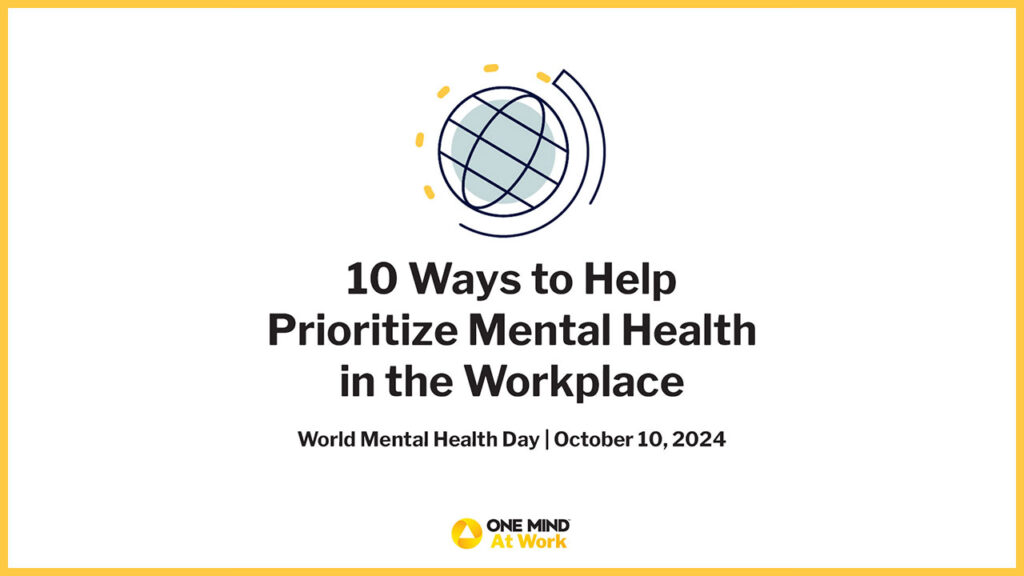10 Ways to Help Prioritize Mental Health in the Workplace

October 10th is World Mental Health Day
The theme for this year’s World Mental Health Day is “It’s time to prioritize mental health in the workplace.” One Mind at Work couldn’t agree more! This year on 10/10, to celebrate World Mental Health Day, we’re sharing 10 tips for how you can contribute to a mentally healthy workplace. Employees at every level of seniority and influence can engage in this work. Our tips and resources will give you inspiration for how you can get more involved this World Mental Health Day and beyond!
1. Mental Health Strategy
Every new business initiative needs a strong, comprehensive, and clearly communicated strategy. Workplace mental health should be no different, but only 1 in 4 organizations who have completed the Mental Health at Work Index have a strategy. What can you do to change that?
As a leader, prioritize the creation of a standalone mental health strategy to reinforce and follow through on your organization’s commitment to worker mental health. Assign resources ($$ & time), carve out time to participate, and check in often to make it happen!
As an employee, consider how your team and/or work plan fits into an organizational mental health strategy. Whether or not your organization has a formal strategy in place, this practice can illuminate the work you can do (and control) to reinforce positive mental health within your scope. Try making time to check in with coworkers about their lives and how they’re doing, communicate to support one another’s workloads when possible, and formalize your own resiliency practices like taking a walk.
Resources:
2. Leadership
Leaders have the opportunity, and responsibility, to steward a psychologically safe culture that values worker mental health. Executive leadership certainly sets the tone for organization, but employees at all levels can engage in behaviors that support a mentally healthy working environment for themselves and their colleagues.
As a leader, shout your commitment to mental health from the rooftops! Communicate often about the link between worker mental health and organizational performance. Share your own experiences with mental health, talk about the tools you use, and keep the conversation alive. Your leadership and participation directly impact the culture of mental health at your organization.
As an employee, you can embrace your own mental health leadership in any role by making it a priority to check on your coworkers. Simply asking how they’re doing and knowing the internal resources available to them to pass on contributes to a culture of mental wellbeing.
Resources:
- Leaders, sharing your own mental health story can help you become a better ally
- Caring for colleagues’ mental and emotional health
- HAA Tips for sharing your story
3. Organizational Culture and Impact
You’ve all heard the saying, culture eats strategy for breakfast. Culture in the workplace is a combination of the behaviors and norms that drive how people communicate, collaborate, and get their work done. Making sure that a commitment to mental health is embedded in those behaviors, norms, and beliefs helps an organization build a strong culture that stands the test of time.
As a leader, are your policies aligned with your workforce mental health strategy? If not, bring the right people together to begin to align policies and practices with mental health priorities. Policies and practices related to hiring, onboarding, compensation, scheduling, code of conduct, PTO, DEI, social responsibility, accommodations, and more all relate to mental health.
As an employee, while one employee does not make up an entire organizational culture, positive employee behaviors are contagious. Contribute to your organization’s culture of mental health by treating people with civility and respect, prioritize fairness within your role’s responsibilities, support fellow workers, and do what you can to foster a sense of community within your team.
Resources:
4. Workforce Involvement and Engagement
Your organization likely employs a wonderfully diverse community of individuals, and they should all have the opportunity to contribute in some capacity to your approach to mental health and well-being. If you’re not soliciting their input, how can you know you’re meeting their needs?
As a leader, consider who is responsible for your organization’s mental health strategy. Establishing a cross-functional team for workforce mental health can help bring more workers’ experiences into your strategic approach.
As an employee, engage more in your organization’s mental health strategy and programs by joining a mental health related employee resource group (ERG) or by becoming a Mental Health champion. If these opportunities don’t yet exist, ask your manager or HR leader about ways to participate.
Resources:
- Listen to what employees need and act on it
- Creating a workplace culture that values mental
- Focal brief: What happens to workforce mental health when you add diversity, equity, inclusion, and belonging to the mix?
5. Work Design and Environment
How your organization designs work and the workplace (whether in office or at home) impacts the mental health of your workforce. Understand the risks associated with work design and environment, so that you can intentionally mitigate them and safeguard workers’ psychological safety.
As a leader, work with the relevant departments to prioritize a comprehensive risk assessment process that is regularly reviewed and informs organizational mental health strategy initiatives. Empower leaders and staff throughout the organization to respond to risks they see in daily life and engage in creating mental health priorities up the chain.
As an employee, identify the ergonomic and environmental improvements that would make your work environment better and work with your organizations available resources to make those changes. In terms of work design, share with your manager and/or bring up with your team when you’re experiencing work underload or overload.
Resources:
- Increase employees’ options for when, where, and how they work
- Psychological health and safety – assessing psychosocial hazards
6. Communication
One of the ways a company can signal a commitment to mental health is to talk about it… a lot. Maintain open, clear, and consistent communications throughout your organization across all levels and worker segments to ensure people are getting all the information they need to know about benefits and programming to support their mental health and well-being.
As a leader, consider all stakeholders internal and external to your organization and ensure there are communications about mental health reaching them all. Utilize a range of communications channels to ensure that different worker segments, levels of the organization, and stakeholders external the the organization receive mental health messaging.
As an employee, pay attention to your fellow employees and those on your team in particular. Invest in learning communication skills and tools to help you notice and address mental health topics with your team. Having conversations about mental health with your colleagues can reduce stigma and provide an opportunity to share important resources.
Resources:
7. Training Specific to Mental Health
Mental health education is a great way to build awareness and empathy, and to remind people of resources that are available to them and their dependents. Be intentional about your approach to training and think carefully about your target audience and your desired outcomes.
As a leader, work with those responsible for learning and development to provide mental health training on an ongoing basis to support internal organizational priorities. Make sure trainings are available and offered to a wide range of worker segments and departments covering a wide range of mental health topics.
As an employee, participate in the mental health training that your organization offers to enhance your mental health awareness and understanding of available resources. Equipped with more knowledge, experience, and tools to address mental health in the workplace, you can become a champion.
Resources:
8. Mental Health Resources and Benefits
Most working adults receive their mental health benefits through the workplace. Mental health benefits should be affordable, accessible, and evidence-based.
As a leader, review your organization’s current mental health resources and benefits and work with human resources to remove barriers to access, address any legal or regulatory gaps, and ensure that workers and their dependents have what they need to utilize the offerings.
As an employee, educate yourself on the benefits available to you, utilize resources relevant to you, and share information about what is available with your team and other colleagues.
Resources:
9. Related Employment Practices
There are lots of benefits that don’t *feel* like a mental health benefit, but when implemented properly can be incredibly protective for an employee’s well-being. And on the flipside, if a policy isn’t designed well or a benefit is difficult to access, it can create undue stress and anxiety. Evaluating and continually improving related employment practices is essential to a comprehensive workforce mental health strategy.
As a leader, allocate resources for practices like rewarding and recognizing employees’ work, professional development, and diversity, equity, inclusion, and belonging programs. A comprehensive suite of related employment practices can contribute significantly to a culture of mental wellbeing.
As an employee, consider engaging in organizational programs like overall wellness offerings that have a significant impact on mental health.
Resources:
- The future of work is employee well-being
- Managing employee recognition programs
- Guide to developing a Strategic Diversity, Equity and Inclusion plan
10. Measuring, Monitoring, and Reporting
A great strategy can become a living document, serving an organization for years to come if its objectives and programs are well measured and improved upon. An organization’s strategy for mental health should include various ways of measuring success, monitoring improvement, and reporting internally and externally for transparency.
As a leader, complete the Mental Health at Work Index! Share insights from your assessments with employees, your board, and other relevant stakeholders. Evaluating your work and sharing progress can create accountability and drive momentum for further action.
As an employee, pay attention to organizational reports and updates about progress on the mental health strategy and its programs. Share your experience in workforce surveys and other opportunities to provide honest feedback to contribute to the continuous improvement of the mental health strategy.
Resources:
For more on One Mind at Work visit https://onemindatwork.org
